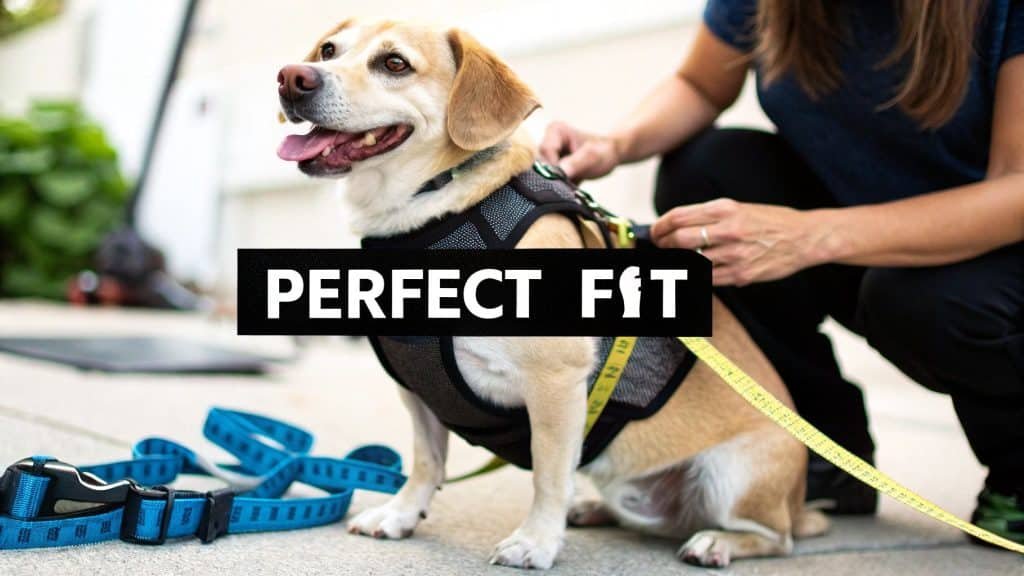Find the Best Dog Vest for Your Pet | Top Picks & Tips
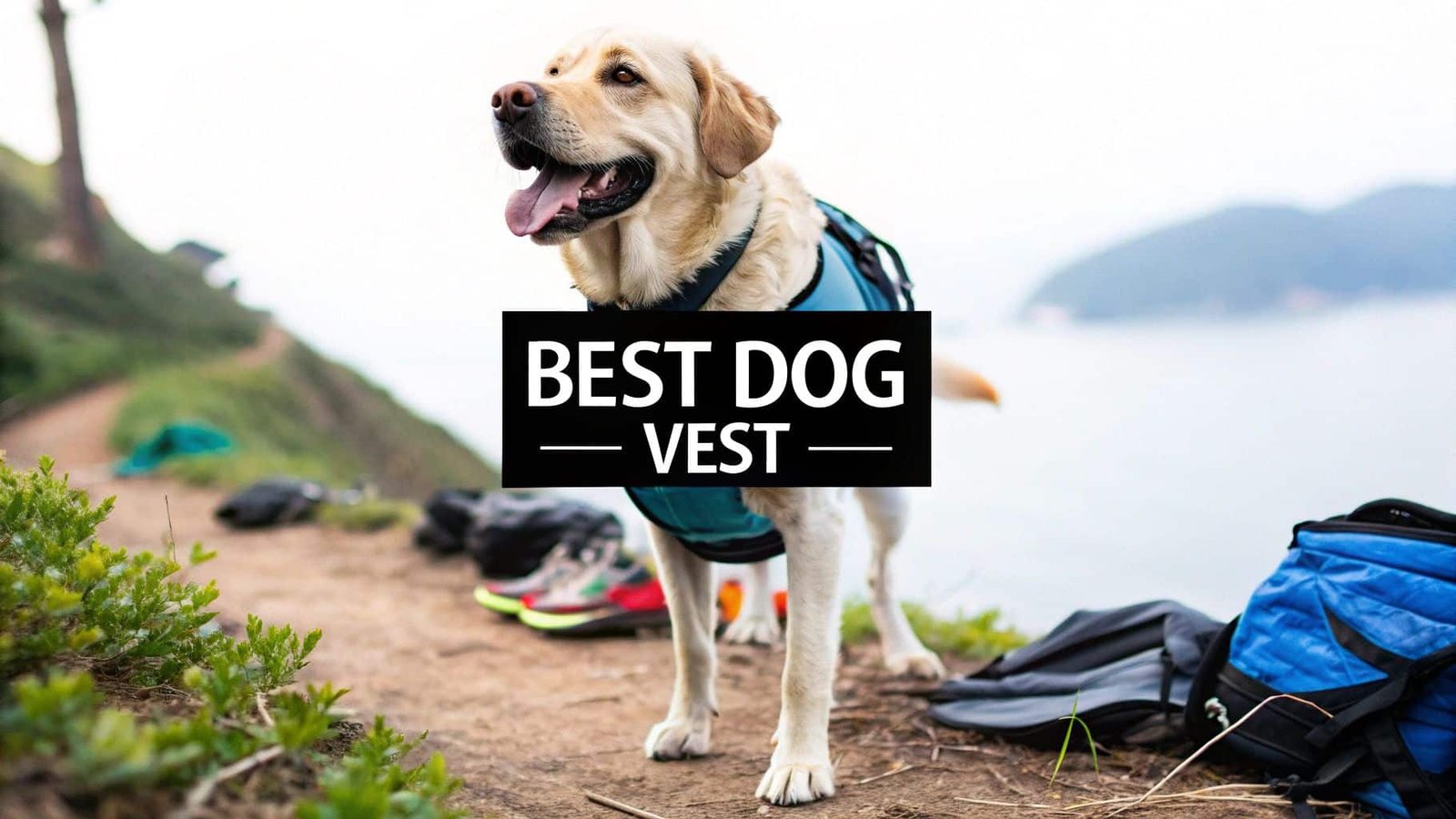
Picking the best dog vest isn’t a one-size-fits-all situation. It really comes down to what you and your dog love to do together. You’ve got options ranging from buoyant life jackets for days on the lake, insulated coats for chilly winter hikes, and even high-visibility harnesses for those late-night city walks.
Nailing the right choice means your dog is safer, more comfortable, and ready for anything.
Why the Right Dog Vest Matters
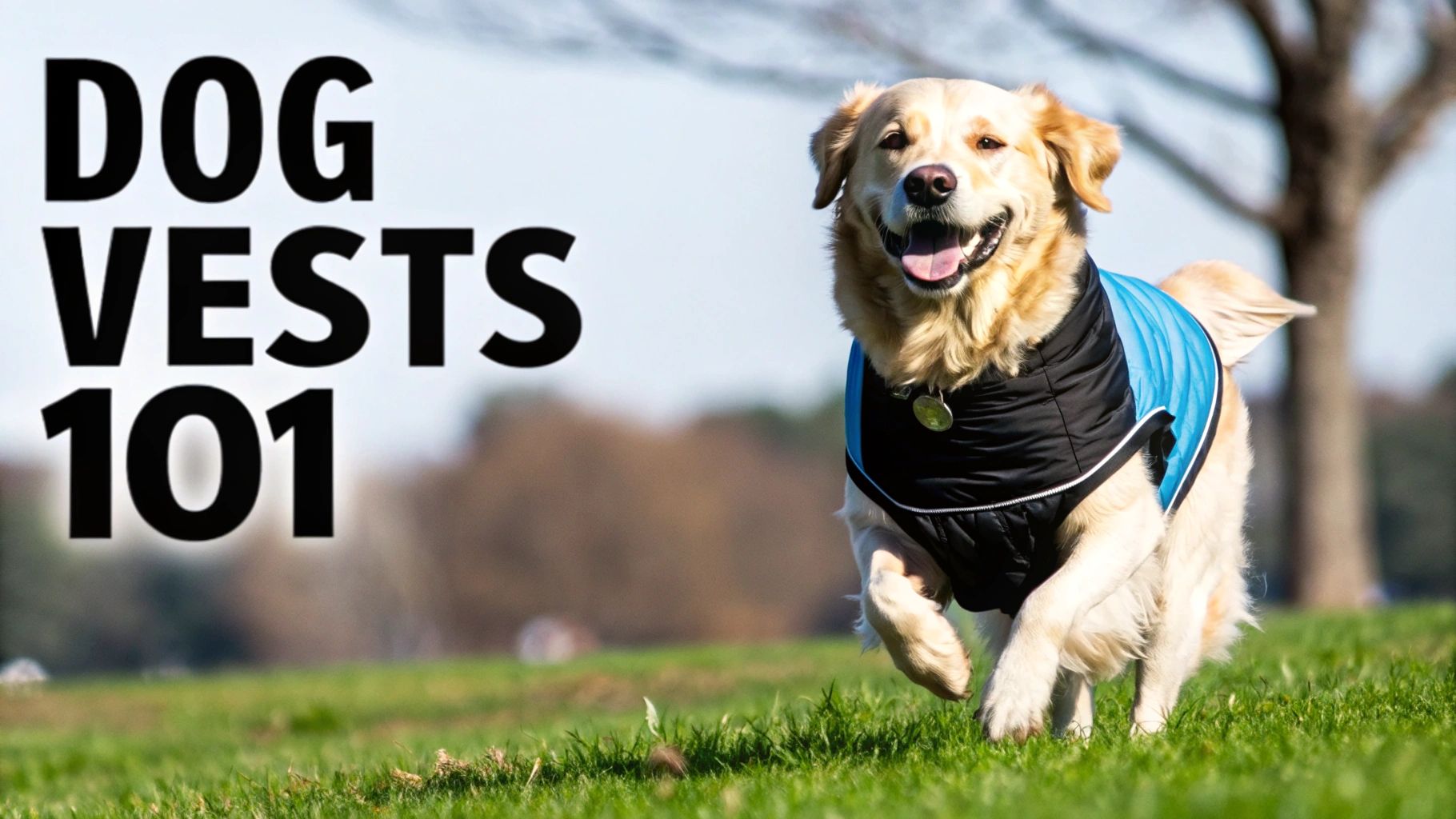
Choosing a dog vest is so much more than just grabbing another piece of gear. Think of it as an investment in your dog’s safety and, frankly, your own peace of mind. The right vest gives you the confidence to bring your best friend along on more of life’s adventures, knowing they’re protected.
Let’s get practical. A bright, buoyant life jacket isn’t just a cute accessory on a boating trip; it’s a lifesaver that keeps your dog afloat and easy to spot if they go overboard. Or imagine a long summer hike—a simple cooling vest can be the difference between a fun day on the trail and a dangerous case of overheating.
Enabling More Shared Adventures
A good vest quickly becomes a go-to tool that strengthens the bond you share. It’s the bright harness that keeps you calm during a nighttime walk downtown or the tough, padded vest that saves your dog from scrapes and thorns on a rugged trail.
This focus on specialized, quality gear is something we’re seeing everywhere. In fact, the pet accessories market has exploded, showing a 450% expansion over the last 25 years. This isn’t just about cute outfits; it’s about owners investing in their pets’ well-being and safety. You can dive deeper into pet industry statistics to see just how much spending on safety gear has climbed.
The right vest doesn’t just protect your dog; it empowers you. It removes hesitation and allows you to say “yes” to more activities, creating a richer life for both of you.
When you choose a vest for its quality and function, you’re not just buying a product. You’re unlocking new possibilities.
Ultimately, the best dog vest is the one that lets you and your companion explore the world side-by-side with confidence. It’s all about making sure they’re comfortable and secure, no matter where the journey takes you.
How to Measure Your Dog for a Perfect Fit
A vest that doesn’t fit right isn’t just a nuisance—it’s a serious safety hazard. I’ve seen too many vests that are too loose, causing dangerous snags on trails, or too tight, restricting a dog’s breathing. Guessing the size based on your dog’s weight is a recipe for a bad fit.
The best way to get it right is to grab a soft measuring tape and get some precise numbers. It only takes a minute and ensures the vest can do its job, whether that’s keeping your dog afloat or visible at night.
First, get your dog to stand up straight. If you’ve got a wiggly pup, a few high-value treats or their favorite squeaky toy can work wonders to keep them still. A calm, natural stance is what you’re aiming for.
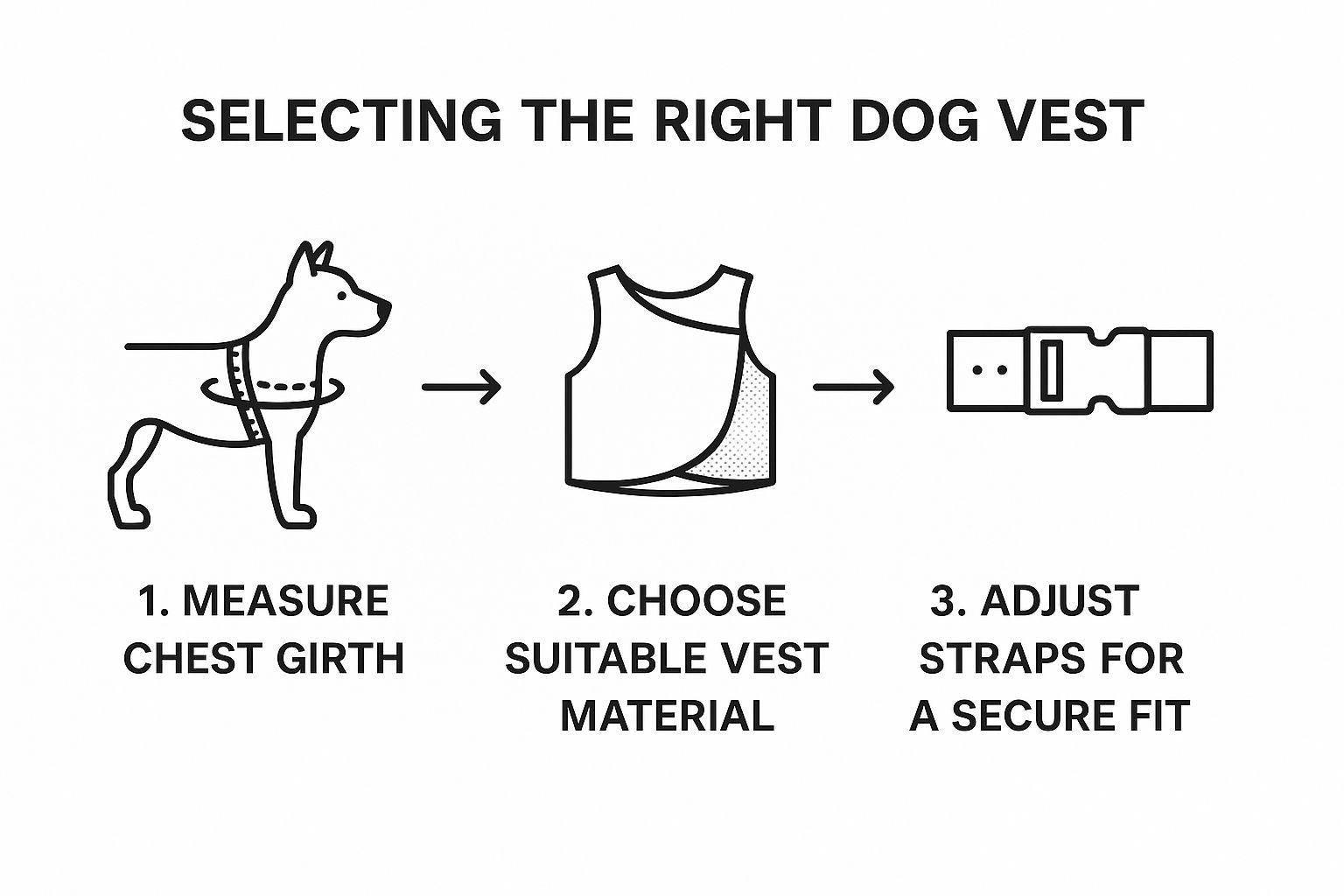
The Three Core Measurements
There are really only three key measurements you need for a great fit. When you’re measuring, keep the tape snug but not tight. A good rule of thumb is that you should be able to comfortably slide two fingers underneath the tape.
- Neck Girth: Wrap the tape around the thickest part of your dog’s neck, right where their collar usually sits. This is especially important for vests with a front chest plate.
- Chest Girth: This is the big one—the most critical measurement for almost any vest or harness. You’ll want to measure around the widest part of your dog’s chest, typically right behind their front legs.
- Body Length: Start at the base of the neck (think top of the shoulder blades) and measure all the way to the base of their tail. This ensures the vest is long enough for proper coverage without getting in the way of their tail or hind legs.
Once you have your numbers written down, compare them to the manufacturer’s sizing chart. And I mean that specific manufacturer. A medium from Ruffwear is not the same as a medium from Kurgo, so always, always check the chart for the product you’re buying.
My Personal Tip: If your dog lands squarely between two sizes, always go for the larger one. You can almost always tighten a slightly bigger vest for a perfect, secure fit, but a vest that’s too small is completely useless and can be dangerous.
Picking the Right Features for Safety and Comfort
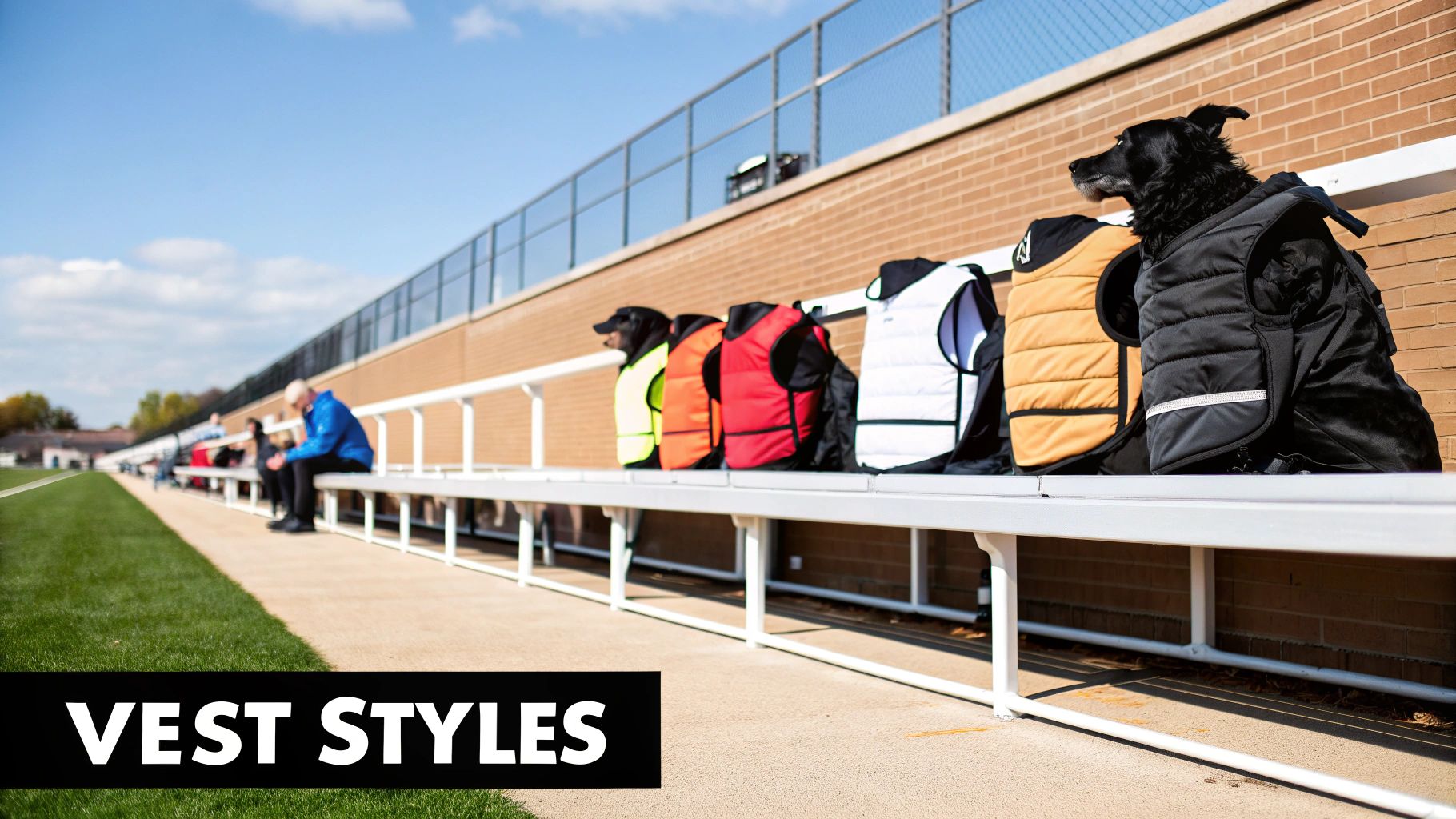
So, you’ve measured your dog and found the right size—that’s a great start. But now we get into the details that truly separate a fantastic vest from a mediocre one. The materials, the stitching, the hardware… this is where a vest proves its worth in the real world, keeping your dog safe and comfortable.
Think about your specific adventures. If you and your dog spend weekends bushwhacking through dense trails, you’ll want a vest made from something tough like ripstop nylon. That kind of fabric can take a beating from branches and thorns without tearing. But if your dog is more of a water baby, a flexible neoprene vest is a much better call, giving them the freedom they need to swim comfortably.
Visibility and Hardware: The Non-Negotiables
Visibility is probably the single most important safety feature, and it’s something I never compromise on. You need to be able to spot your dog in a split second, whether they’ve wandered off the trail at sunset or they’re in choppy water. That’s why bright, almost obnoxious colors like neon orange, yellow, or red are your best friends.
On top of that, look for reflective trim or piping. It’s a simple addition, but it’s absolutely essential for any low-light activity. A little bit of reflective material can catch the beam of a flashlight or a car’s headlights from far away, making all the difference.
The hardware—the handles, buckles, and rings—is just as critical. Here’s what I always check for:
- A Solid Rescue Handle: This isn’t just for looks. The handle needs to be rugged and stitched securely enough for you to lift your dog’s entire weight. You’ll be grateful for it when you need to hoist them back into a boat or help them over a tricky obstacle on a hike.
- Multiple Adjustment Points: A vest with straps at the neck and around the chest is ideal. This lets you dial in the fit perfectly, preventing any uncomfortable rubbing or chafing while making sure the vest doesn’t shift or slip off when your dog is moving.
- Smart D-Ring Placement: The leash attachment point, or D-ring, should be heavily reinforced. For dogs that pull, a D-ring on the chest can give you better control. For most everyday walks and hikes, a standard D-ring on the back works great. If you need something with even more security and utility, a quality tactical dog harness is worth a look.
Essential Dog Vest Feature Checklist
Choosing a vest can feel overwhelming with all the options out there. This quick checklist can help you cut through the noise and focus on what truly matters for your dog’s safety and your peace of mind.
| Feature | Why It’s Important | Look For |
|---|---|---|
| Bright Colors | Ensures you can easily spot your dog in any environment, from trails to open water. | Neon orange, yellow, green, or bright red. |
| Reflective Trim | Critical for visibility in low-light conditions, like dusk, dawn, or near roads. | Strips, piping, or patches that reflect light. |
| Sturdy Handle | Allows you to quickly and safely lift or guide your dog out of trouble. | Reinforced stitching, comfortable grip, and robust material. |
| Secure Buckles | Prevents the vest from coming undone during activity, ensuring a constant, reliable fit. | Quick-release buckles made from durable plastic or metal. |
| Multiple Straps | Provides a snug, customized fit that avoids chafing and prevents the vest from shifting. | At least two adjustment points (neck and chest). |
| Durable Fabric | Withstands wear and tear from rough terrain, water, and sun exposure. | Ripstop nylon for hiking; neoprene for swimming. |
| Buoyancy Panels | (For life vests) Keeps your dog afloat and their head above water in an emergency. | Foam panels placed around the neck and back. |
Use this table as a guide when you’re comparing different vests. Ticking off these boxes ensures you’re getting a product that’s built for both performance and protection.
Tailoring Features to Your Activities
The best vest for your dog is the one that’s built for what you two actually do together. It’s no surprise that the global dog life vest market, once valued at around USD 128.5 million, is expected to keep growing as more people include their dogs in water sports. This trend, highlighted in dog life vest market reports on verifiedmarketreports.com, just proves how important specialized gear has become.
For a dog on a boat, the top priority is buoyancy. You want a life vest with extra flotation around the neck to keep their head above the waves. For a hiking dog, that same vest would be overkill. Instead, you’d want something lighter with a reinforced handle and tough fabric.
Thinking through these practical scenarios is key. A bulky life jacket would just get in the way on a long, hot hike, while a simple walking harness is completely useless in the water. It’s all about matching the gear to the adventure.
Find the Right Vest for Your Dog’s Lifestyle
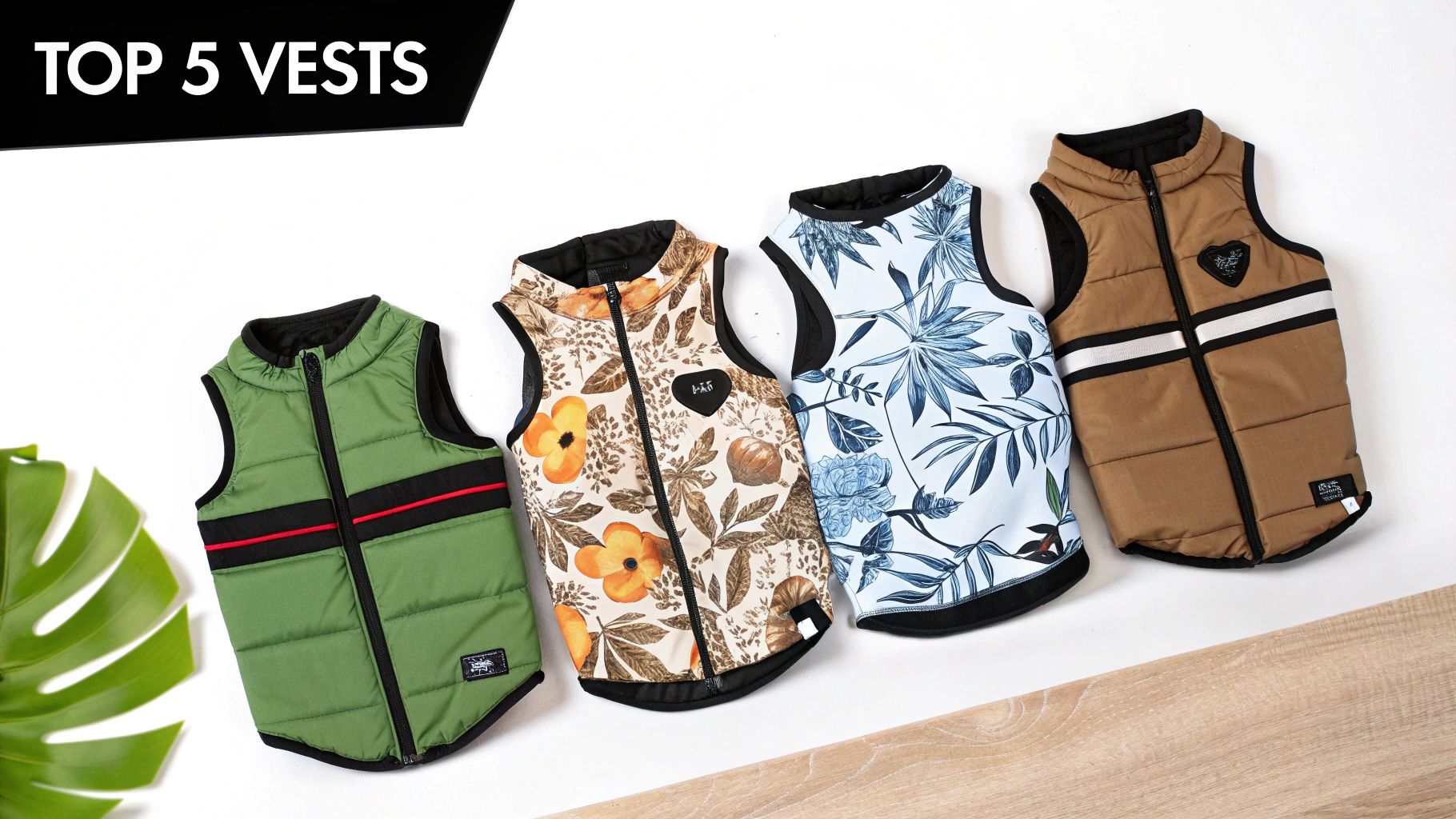
The “best” dog vest isn’t a one-size-fits-all solution. The perfect gear for your dog is the one that fits seamlessly into your shared life. Instead of drowning in endless options, just think about what you and your dog actually do together. That simple question will quickly narrow down the features that truly matter.
This lifestyle-first approach cuts right through the marketing noise. Are you two hitting the trails every weekend? Or is your world more about navigating busy city streets? Your answer points you straight to the right gear.
For the Weekend Warrior
If your Saturdays are all about dirt paths and scenic overlooks, your dog needs a vest that’s as rugged as the terrain you’re exploring. For these hardcore hikers and trail runners, durability is everything.
Look for vests made from tough, abrasion-resistant fabrics that won’t snag or tear on branches and rocks. A sturdy, well-placed rescue handle is also a must-have. It’s invaluable for helping your buddy over a fallen log or up a tricky scramble. Multiple adjustment points are key here, too—they ensure a snug fit that won’t shift, even when your dog is bounding over obstacles.
For the Water Sport Enthusiast
Summers spent by the lake, on a boat, or at the beach call for a specialized dog life jacket. Don’t even think about using a regular harness. These vests are specifically engineered for buoyancy, using foam panels placed to keep your dog’s head above the surface.
Fit is absolutely critical. You want it snug enough that they can’t slip out, but it can’t be so tight that it restricts their natural swimming motion.
The market for this gear has exploded as more owners prioritize safety. In fact, the global dog life vest market was valued at $131 million and is still growing. You can read more about the dog life vest market on datainsightsmarket.com. Look for features like quick-draining materials and a bright, high-visibility color.
A simple walking harness offers zero protection in the water. Investing in a proper life vest is a non-negotiable part of responsible water recreation with your pet.
For the Urban Explorer
City life comes with its own set of challenges. When your adventures are more about concrete jungles than actual ones, your focus should shift to visibility and lightweight comfort.
A harness with plenty of reflective stitching or trim is crucial for staying safe during those evening walks or in heavy foot traffic. You need to be seen by cars, cyclists, and pedestrians.
Since city dogs often wear their gear for shorter, more frequent outings, comfort is also a top priority. A vest with breathable mesh panels and an ergonomic design that doesn’t chafe or restrict movement is ideal. You can find some fantastic options in our full collection of dog collars, leashes, and harnesses.
Getting Your Dog to Love Their New Vest
You’ve found the perfect vest, brought it home, and now for the most important part: convincing your dog it’s the best thing ever. The real goal is to have them wiggling with excitement every time you pull it out. A little patience now goes a long way in making the vest a signal for adventure, not a source of stress.
First things first, just leave the new vest on the floor in a high-traffic area, like the living room. Don’t make a big deal out of it. Let your dog discover it on their own time. When they eventually go over to sniff or nudge it, shower them with praise and a high-value treat. Do this a few times over a day or two. The idea is to let them get comfortable with its sight and smell without any pressure.
Building a Positive Vibe
Once your dog seems unbothered by the vest’s presence, you can take it a step further. Pick it up and hold it. If they look at it, give them a treat. Then, gently touch the vest to their back or shoulders for just a second, followed immediately by another reward.
You’re teaching them a very simple but powerful lesson: vest = good things happen.
Keep these initial training moments super short and sweet—a minute or two is plenty. If you notice any hesitation, like your dog backing away or tucking their tail, that’s your cue to slow down. A calm, patient approach is non-negotiable, especially for dogs who are already a bit anxious. For more insights on helping a stressed pup, our guide on the best dog beds for anxiety has some great tips.
The First Time On
When your dog is relaxed and happy with the process, it’s time to try it on. Gently drape the vest over their back, but don’t clip any of the buckles just yet. Let them stand with it on for a minute while you continue the praise and treats, then take it right off.
Pro Tip: When you’re ready to buckle it up for the first time, timing is everything. Clip it on right before you feed them dinner or head into the backyard for a game of fetch. This master move connects the vest directly to their absolute favorite activities.
For that very first walk, keep it brief and enjoyable. Afterwards, be sure to check under the straps for any signs of rubbing or chafing. By building this foundation of fun and comfort, your dog will quickly learn that seeing their vest means an awesome adventure is about to begin.
Common Questions About Dog Vests
Even after you’ve picked out what seems like the perfect vest, you’re bound to have some questions once you start using it. Let’s tackle a few of the most common ones that pop up for dog owners, drawing on real-world experience to make sure you’re using your gear the right way.
Getting these details right is about more than just convenience—it’s about keeping your dog safe and comfortable on every outing.
https://www.youtube.com/embed/KVCNH96HqFs
How Do I Know This Life Vest Is Really Buoyant Enough?
A life vest’s whole purpose is to keep your dog afloat, but weight guidelines on the tag don’t always paint the full picture of how it performs in the water.
The only way to be certain is to do a test run. Find some calm, shallow water and let your dog have a supervised swim. You’re looking for more than just basic flotation. A great life vest will actually help position their head comfortably above the water, especially as they start to get tired.
A vest’s true test is in the water. Pay close attention to how well the front flotation panels work. Their job is to keep your dog’s nose and mouth clear of the water, which is the single most important safety feature.
Can I Put a Harness On Under a Life Vest?
I hear this one all the time, and the answer is a hard no—it’s just not safe. Layering a harness under a life vest introduces a mess of straps that can easily get snagged on underwater hazards like submerged branches or rocks. It’s a serious drowning risk.
The safest approach is to use a life vest that has a built-in, reinforced D-ring for your leash. This keeps everything streamlined, gets rid of potential snag points, and guarantees your leash is connected to the strongest part of the vest.
When Is It Time to Replace a Dog Vest?
Dog vests don’t come with an expiration date. How long one lasts comes down to how often it’s used and how well you take care of it. Forget the calendar; you need to become your own gear inspector.
Before you head out, give the vest a thorough once-over. You’re looking for any signs of wear that could compromise its integrity.
- Frayed Straps: Any sign of fraying means the strap is weakened and could snap.
- Cracked Buckles: Plastic gets brittle over time. A cracked buckle can fail when you least expect it.
- Degraded Foam: Squeeze the flotation panels. If they feel stiff or you can feel the foam crumbling inside, it’s lost its buoyancy and needs to be replaced.
If you spot any of these red flags, it’s time for a new vest. No exceptions.
Ready to find the perfect vest for your next adventure? Ur Pet Store has a curated collection of high-quality, durable vests designed for safety and comfort. Shop our full selection today and get ready to explore with confidence.


